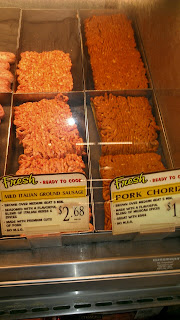In no way can I consider durian “local,” but I did say at the outset that I also like to experiment with unusual ingredients. Durian definitely qualifies on that score.
I found it at the Hong Kong Market, a positively cavernous Asian grocery in Houston’s Chinatown. Durian originate in Brunei, Indonesia, and Malaysia. Their claim to fame: the aroma. Some find the odor pleasant, others revolting. Many Asian hotels prohibit durian due to its overpowering fragrance. How could I resist? After determining that the whole fruit had no significant smell (I had to drive three hours with it in the car, after all), I placed it in the cooler and headed home.
 |
| Outdoor Containment Unit |
Not knowing if it would commence to stinking as it defrosted, I banished it outside overnight, with a plant atop to discourage curious raccoons. We dispatched it on Monday night in order to dispose of the stinky remains in the next day’s trash.
The odor wafted out as Bruce made the first cut. The best way to describe it is “funky tropical.” Kind of like your favorite funky cheese, but with a mango or guava undertone. Some think it smells of almonds, but that does almonds a disservice. We didn’t find the aroma unbearable, although I can understand how it would be gag-inducing for some. (Apparently the iron-stomached Andrew Zimmern, of “Bizarre Foods,” can’t or won’t touch them.)
The glistening flesh had the rather off-putting consistency of a stringy marshmallow and was quite sticky, with a slight yellowish tint. Bruce managed to scoop out about a cup of flesh from the coconut-sized fruit. He also removed several large pits (which apparently can be eaten if cooked. No way I am cooking those things in my house.)
We decided a fruit smoothie would work best for a tasting, so we spun it up in the blender. The smoothie would have tasted better with less durian, as its flavor pretty much overpowers anything else. Banana would have made a good pairing.
And no, I didn’t finish it.

















































